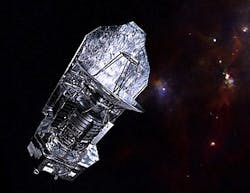Thermal expansion of ceramic and silicon optical substrate materials measured at low temperatures
Within the scope of a recently completed European Space Agency (ESA) project, the Physikalisch-Technische Bundesanstalt (PTB; Braunschweig, Germany) measured the thermal expansion of ultrastable ceramics such as silicon carbide as well as that of single-crystal silicon in the temperature range from -266 °C to +20 °C with high accuracy.1 Such information is valuable in the design and fabrication of, for example, large space telescopes like the ESA's Herschel infrared observatory.
The investigations have also shown that the values used so far for the reference material single-crystal silicon must be corrected.
Previous simulation had errors
Space telescopes such as Herschel explore spectral ranges that are not accessible from the Earth; they can therefore only be used in space. How critical it is to know the exact thermal expansion of the materials used when setting up such telescopes was clearly demonstrated during one of the latest ESA missions, as it was revealed that the simulations performed previously were not in agreement with the manufactured mirrors. The discrepancies were fortunately not discovered in space, but still led to unnecessary delays. To prevent such unpleasant surprises from recurring in the future, in-depth investigations of the materials used were required.
For their investigations within the scope of the ESA project, René Schödel's research group used PTB's ultra-precise interferometer to measure the length of the samples across the whole temperature range with nanometer accuracy. This Twyman-Green interferometer, which uses three lasers tuned to the hyperfine levels of iodine and rubidium, is the only one of its kind in the world.
At low and descending temperature, silicon starts to expand
To allow measurements to be taken with similar accuracy but with less effort, even at other institutes, reference materials whose exact thermal expansion is known are usually used for comparison. One such reference material is single-crystal silicon, which is characterized by a continuous lattice structure with very few defects; it was also investigated by the researchers. Similar to some of the ultrastable ceramic materials, silicon exhibits a peculiar behavior: at low temperatures, it starts re-expanding below a certain temperature.
This dynamic characteristic (which is rather unexpected in everyday life) was also exactly measured by the scientists from PTB. Their measurements yielded an important result: across a vast temperature range, they discovered significant deviations from the reference values used to date for single-crystal silicon. This suggests that the reference values must be corrected. The results of the project are of importance for further space missions that have already been planned, such as the James Webb Space Telescope (JWST), for which temperatures of use below -220°C are planned, or the Space Infrared Telescope for Cosmology and Astrophysics (SPICA), for which even lower temperatures of use are envisaged.
Source: http://www.ptb.de/cms/en/presseaktuelles/journalisten/press-releases/press-releases-article.html?tx_news_pi1[news]=6864&tx_news_pi1[controller]=News&tx_news_pi1[action]=detail&tx_news_pi1[day]=23&tx_news_pi1[month]=11&tx_news_pi1[year]=2015&cHash=1d858f753151543a9acf7d9ccad0c7f9
REFERENCE:
1. Thomas Middelmann et al., Physical Review B 92, 174113 (2015) -- published 19 November 2015

John Wallace | Senior Technical Editor (1998-2022)
John Wallace was with Laser Focus World for nearly 25 years, retiring in late June 2022. He obtained a bachelor's degree in mechanical engineering and physics at Rutgers University and a master's in optical engineering at the University of Rochester. Before becoming an editor, John worked as an engineer at RCA, Exxon, Eastman Kodak, and GCA Corporation.
